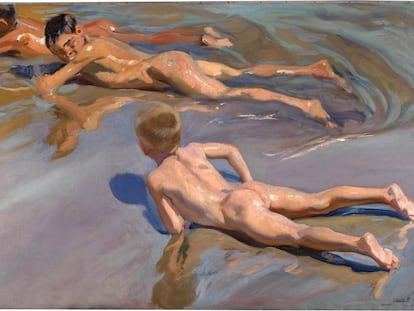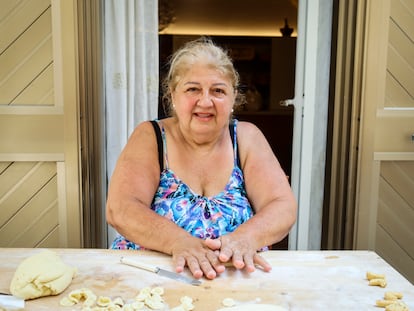Joana Vasconcelos, artist, aristocrat and karate fighter: ‘Madonna told me that she and I do the same thing’
The Portuguese creator reflects on the feminine, the domestic and being recognized in the supermarket
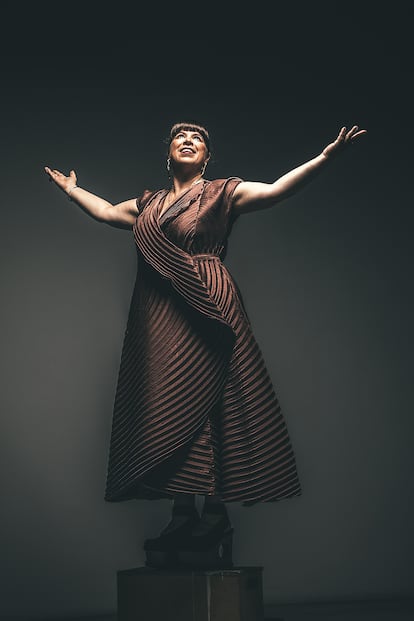
Over her quarter-century career, Joana Vasconcelos has perfected both the art of the spectacle and that of discretion. Weeks after this meeting in Madrid, she would unveil his most ambitious work to date, The Wedding Cake, a 12-meter pavilion in the Rothschild Foundation’s gardens shaped like a three-tier cake with more than 15,000 ceramic tiles. She would also reveal her second collaboration with Dior, deploying an immense textile sculpture in the form of a tentacle dome for the F/W 2023/2024 show. But at the moment of the interview, she prefers not to talk about projects that have not yet seen the light of day. Her quick stop at Club Matador in Madrid was for a simpler reason: the Liquid Love artist’s notebook, which accompanies this year’s edition of Matador magazine and which collects the water-related works to which the Portuguese artist feels most emotionally attached.
Q. From your house you can see the mouth of the Tagus, your workshop is in the port, and you like to draw in your bedroom, looking at the ocean through the window. Why is water so important to you?
A. Living by the water is like living by a mountain: these environments that have an impact on who you are. I cannot live isolated from it and, at the same time, I feel privileged because I am aware that many people do not have access to it. Much of my work is based on bringing the domestic and luxury closer together, and that has a direct connection with water, which has become one of the great luxuries.
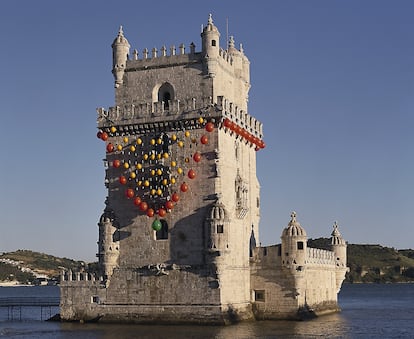
Q. Why are you attracted to luxury as a subject?
A. My path lies between the banality of the domestic and the impact of the luxurious. I am very interested in building a bridge, changing the identity between one and the other, because it helps me to re-evaluate predetermined ideas.
Q. Are you descended from Portuguese royalty?
A. My great-great-grandmother was from Braganza and sailed to Brazil with the Portuguese court after the Napoleonic invasion. There she was duchess of the queen. Then she became pregnant by the king. I had a great-great-grandmother who was the king’s bastard daughter — quite a story. When they returned to Portugal, their daughter married into a Vasconcelos, a noble family. My grandfather kept the duke’s ring, but then he went Republican. As a child, she would take me to a palace in Sintra where all the coats of arms are, and she would tell me: “This is our family.”

Q. And you were born in Paris because your parents had to leave during the Salazar dictatorship.
A. Yes, they were revolutionaries, from the Maoist left. They were against the colonial war and went into exile in Paris to avoid participating in it. My father was a photojournalist and my mother an interior designer.
Q. How did your family take the fact that you wanted to be an artist?
A. They weren’t caught by surprise. My grandmother Alice was a painter, and my grandfather Álvaro told me that it took many generations to have an artist in the family. I also had an uncle, who was jailed for being a Republican, who loved to embroider. My family was odd. Upon returning from Africa, my grandfather bought two apartments facing the sea in Lisbon, one opposite the other. My aunt lived with them. She married very late and studied very late too, but she was one of the first Portuguese women to graduate in French literature at the Sorbonne and did a doctorate in philosophy. When I first came to Lisbon, I had just finished studying at the French school, which was super posh. My grandparents thought that was awful. So I entered alternative schools. They had me take private Portuguese classes with my aunt. Everyone thought she was teaching me language, but in reality she was teaching me philosophy.
Q. There is a fascinating detail in your biography: at the age of 8 you enrolled in karate classes.
A. And I’m still a karate fighter today! [She pulls out her phone and shows a photo posing with a black belt on a tatami]. This photo is from last week. I was a professional until I was 28 years old.
Q. How does a girl from such an intellectual background decide to give herself over to karate?
A. [Laughs] In my family, cultural and political discussion was constant. My uncle was a commentator at the Institute of Political Studies in Paris. His generation, that of the seventies in Portugal, rebuilt the country after the dictatorship. In my house, there were always big debates, which is why school seemed such an uninteresting place to me. And my father was friends with many young artists. I was lucky to grow up surrounded by singers, fashionistas, painters. But, at the same time, I was a girl in an upper-middle-class neighborhood where there wasn’t much to do. One of the few activities near my house was karate. All my boy friends went, so I said, “Me too.” It was about as far as I could walk on my own.
Q. What has the discipline of karate instilled in your art?
A. My family was so original, so left-wing, that my father didn’t wear a tie because he said it didn’t represent him. There was no TV or Coca-Cola because they were symbols of American imperialism. There was a wonderful component of arbitrariness. And then karate appeared, with all its structure and the teacher’s rigidity. It was pure discipline. I competed. I also did kobudo [a martial art that uses traditional wooden and metal weapons]. Those years helped me develop a very particular knowledge of the body. Later, when I studied art, the intellectual development was a lot more. And, later, I understood that I had to put all three together: the body, the mind and the spirit.
Q. Until its international success, art in Portugal was dominated by men. Why has it taken so long to be taken seriously in your own country?
A. And it’s still a man thing, but it’s interesting to rethink this tradition, because its most interesting and influential precursors are actually women: Vieira da Silva, Paula Rego, Helena Almeida... In Portugal, acceptance has come to me from the people. I’m the artist you recognize in the supermarket. The other day I was in a hurry with my daughter in a shopping center and someone approached me to say: “Sorry, I just wanted to thank you.” I said: “Why?” “For your work.” “Thank you, you give me joy!” I don’t care about criticism, because that is priceless. When people come up to you to say something like that, from the heart, you run out of words.
Q. Part of your success is due to your immediacy, to the fact that it is easy for many people to understand. Do you consider that the idea that art should only be understood by a few is outdated?
A. Many of my colleagues say that they only need recognition from their peers, from the artistic milieu. I think that kind of recognition is very important, but the work of art exists in a much longer sense in time. All humans who decide whether an artist is worthy of attention. I am very lucky. Not everyone has the privilege of having 500,000 people come to see their exhibition.

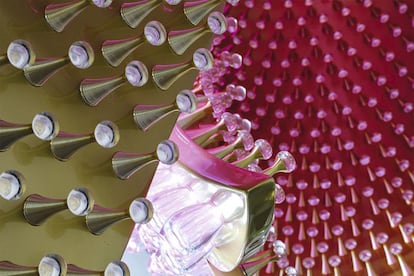
Q. I think Madonna visited your workshop. Did she buy anything?
A. She didn’t buy anything, but she came to see me.
Q. And how did she get to your workshop?
A. Because Valentino, the designer, came to Lisbon and organized a party to which Madonna was invited. When she appeared, I was able to chat with her. She told me: “You and I do the same thing. We talk about the domestic.” She perfectly understood what I do, and we had a super interesting conversation about the conceptual in our work.
Q. You use everyday elements to reflect on the female condition and women’s roles, such as your famous chandelier made of tampons, named The Bride, or the Marilyn shoe made out of pots. Are there many gender stereotypes still to be broken?
A. There are certainly many barriers to break down. And it seems important to me to expose it in a clear way: behind a beautiful image you can send a message that contributes to thinking about those stereotypes. We have arguments about this every day, when we see the news about Iran and the veil, for example. My piece of a burqa crashing to the ground is very graphic and colorful, but it is also meant to be shocking and thought-provoking.
Q. When you were invited a decade ago to be the first woman to exhibit at the Palace of Versailles, you were censored precisely for that piece of the burqa and the tampon lamp. What do you attribute it to?
A. One is a burqa and the other is made of tampons. And you can’t show things like that in Versailles, it’s not correct. That was the justification they gave me. Tell me where that puts the world we live in?
Q. Duchamp, one of your greatest influences, will always be remembered, above all else, for his toilet. In your case, what specific work would you like to be remembered for?
A. Asking an artist that is like asking them to choose between their children. In the same way that many of my works are made to be completed by the viewer, the memory of my works also belongs to the viewers.
Sign up for our weekly newsletter to get more English-language news coverage from EL PAÍS USA Edition
Tu suscripción se está usando en otro dispositivo
¿Quieres añadir otro usuario a tu suscripción?
Si continúas leyendo en este dispositivo, no se podrá leer en el otro.
FlechaTu suscripción se está usando en otro dispositivo y solo puedes acceder a EL PAÍS desde un dispositivo a la vez.
Si quieres compartir tu cuenta, cambia tu suscripción a la modalidad Premium, así podrás añadir otro usuario. Cada uno accederá con su propia cuenta de email, lo que os permitirá personalizar vuestra experiencia en EL PAÍS.
¿Tienes una suscripción de empresa? Accede aquí para contratar más cuentas.
En el caso de no saber quién está usando tu cuenta, te recomendamos cambiar tu contraseña aquí.
Si decides continuar compartiendo tu cuenta, este mensaje se mostrará en tu dispositivo y en el de la otra persona que está usando tu cuenta de forma indefinida, afectando a tu experiencia de lectura. Puedes consultar aquí los términos y condiciones de la suscripción digital.
More information
Archived In
Últimas noticias
Most viewed
- Sinaloa Cartel war is taking its toll on Los Chapitos
- Oona Chaplin: ‘I told James Cameron that I was living in a treehouse and starting a permaculture project with a friend’
- Reinhard Genzel, Nobel laureate in physics: ‘One-minute videos will never give you the truth’
- Why the price of coffee has skyrocketed: from Brazilian plantations to specialty coffee houses
- Silver prices are going crazy: This is what’s fueling the rally
